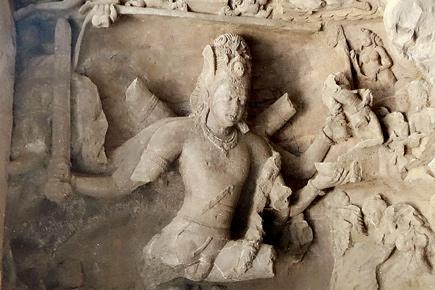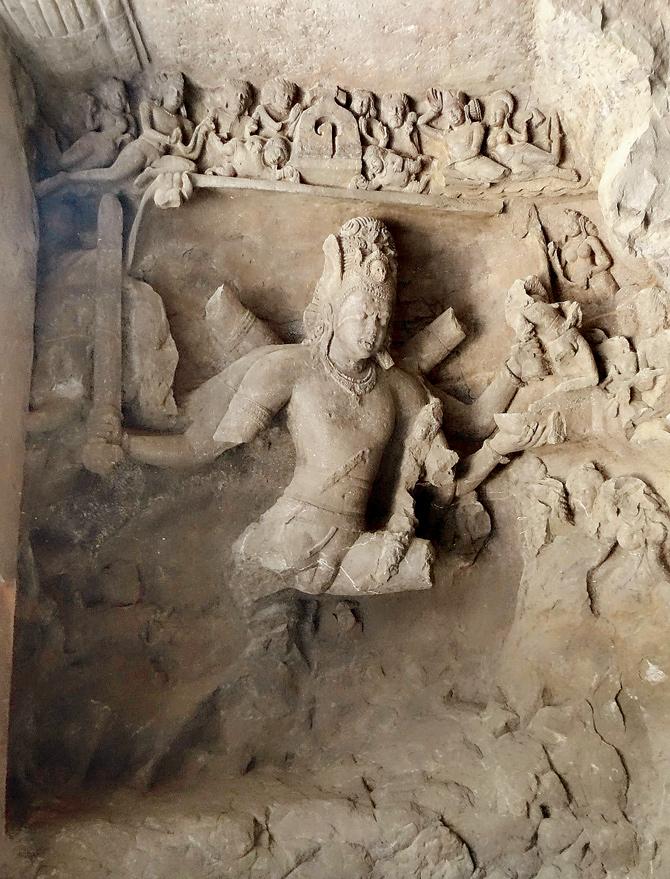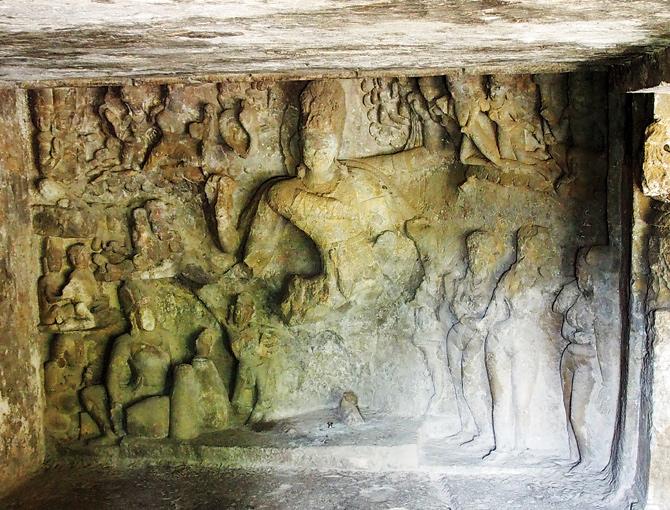A weekend talk on Hindu mythology played out at Elephanta, Jogeshwari and Mandapeshwar caves is reason to make a quick Sunday trip to the ruins

Nataraja at cave 1 at Elephanta
![]() When was the last time you visited a cave site in or near Mumbai? A talk by Dr Prachi Moghe, a post-graduate teacher in Ancient Indian History, Culture and Archaeology from the University of Mumbai, will inspire you revisit these forgotten treasures.
When was the last time you visited a cave site in or near Mumbai? A talk by Dr Prachi Moghe, a post-graduate teacher in Ancient Indian History, Culture and Archaeology from the University of Mumbai, will inspire you revisit these forgotten treasures.
ADVERTISEMENT

Nataraja at cave 1 at Elephanta. Pic courtesy/Sandeep Dahisarkar
The talk is organised by The Katha Project that aims is to bring mythology and history to life through the art of
storytelling and narrative through talks, debates or interactive sessions on ancient ruins, places, beliefs and art forms with mythological or historical significance.
The hour-long talk, this Sunday will discuss how Hindu mythology is reflected in art with reference to Brahma, Vishnu and Shiva Shakti.
“Art and mythology are closely intertwined in the evolution of culture, as art is used to transmit fundamental beliefs, values, ideas and attitudes of society’s culture. The socio-economic life and religion in ancient India fascinates me most,” says Moghe.
Elephanta Caves
These caves house rock cut temples dating back to the 5th century CE. The entire cave temple complex covers an area of about 60,000 square feet and consists of a main chamber and two lateral ones, courtyards and several subsidiary shrines. Above the temple is the mass of natural rock. There are three entrances to the temple. On the west end shrine of this complex, there is a saptamatrika panel where eight figures are shown instead of seven, the only figure which is unique here is the last one with a dhvaja (banner) on top. The 20-feet high image of the three-headed Shiva, the Trimurty is considered to be a masterpiece of Indian art. This colossal image represents Panchamukha Siva, only three faces of whom are carved into the wall and it demands immediate attention upon entering the temple through the northern entrance.
HOW TO REACH: The Elephanta Caves can be reached by ferry from the Gateway of India. Ferries operate from the jetty at regular intervals. It takes one hour to reach the island by sea.
“Indian mythology is one of the richest in the world. Every conceivable type of natural as well as supernatural phenomenon has been anthropomorphised and given colourful histories and tales,” she adds.
Moghe will throw light on Hindu mythology with a special reference to Shaiva mythology reflected in art, and the history and philosophy of Pashupatas. Sculptures from Elephanta, Jogeshwari, Mandapeshwar and Ellorawill be discussed in an attempt to take an overview of sculptural art and the religio-philosophical background of it.
It will also touch base on Kalyansundaram, which is iconographical depiction of the wedding of the Hindu deities Shiva and Parvati. Another topic will be the story of Ravananugraha, a benevolent aspect of Shiva, depicted seated on his abode Mount Kailash with his consort Parvati, while Ravana of Lanka tries to shake it. If time permits, Moghe will also talk about Buddhist mythology found at Ajanta and Ellora in Aurangabad.
ON May 22, 5 pm
AT Mcubed Library, Princess Building, D’Monte Park Road, Bandra (W).
CALL 26411497
ENTRY Free
Jogeshwari Caves
The caves date back to 520 to 550 CE. According to historian and scholar Walter Spink, Jogeshwari is one of the earliest major Hindu cave temples in India. The caves, located off the Western Express Highway, can be accessed through a long flight of stairs into the main hall of the cavernous space. It has many pillars and a lingam at the end. Idols of Dattatreya, Hanuman and Ganesh line the walls. The cave also has a murti and footprints of goddess Jogeshwari (Yogeshwari), whom the area is named after. She is also considered the Kuladevi to some Gujarati Brahmins.

HOW TO REACH: The nearest station is Jogeshwari. One can reach Jogeshwari Caves by boarding a rickshaw from Jogeshwari station from the eastern side. It can also be reached from the Western Express Highway and the Jogeshwari-Vikhroli Link Road.
Mandapeshwar Caves
This cave shrine can be considered among the large-sized mandapa type of cave architecture of the Chalukyan period.
The figures of the main god and the subsidiary attendants, wherever completed, show a reasonably good control over the figure work, proportion and modelling, and thus would pertain to the well-known Chalukyan formulae and traditions.
The whole composition is noted for its slenderness, lack of massive stylisation and perspectives.

Mandapeshwar Natesh. Pic courtesy/Samarth Parab
HOW TO REACH: The nearest station is Borivali. There are number of buses to the site, and autorickshaws will also ply from outside the station.
 Subscribe today by clicking the link and stay updated with the latest news!" Click here!
Subscribe today by clicking the link and stay updated with the latest news!" Click here!






